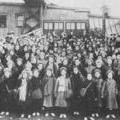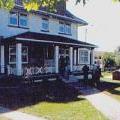 "From 1869 to 1948 more than 100,000 children were immigrated from Great Britain to work on farms in the rapidly growing rural communities across Canada. While this program, administered by groups with the approval of the British Government, was created with good intentions and the promise of a better life, its results were often tragic…
"From 1869 to 1948 more than 100,000 children were immigrated from Great Britain to work on farms in the rapidly growing rural communities across Canada. While this program, administered by groups with the approval of the British Government, was created with good intentions and the promise of a better life, its results were often tragic…
In times of economic crisis [in Britain], many parents placed their children in the care of 'charitable' society homes as a temporary expedient until times improved. Unfortunately, these societies viewed child emigration as a solution to poverty and overcrowding in Britain's cities. Parental consent to a child's emigration was often overlooked, and many parents were never informed of their children's emigration. Others would receive written notification only after the ship carrying their children had left port.
During these years, there existed a shortage of agricultural labour in Canada... Within days or weeks of the children's arrival in Canada, they would be placed on farms to work for their keep... It is now clearly evident that many were ill-treated, neglected and overworked. Today, many of the surviving Home Children still carry the emotional scars resulting from forced emigration from homeland, and separation from families at such a young age.
…Most Home Children would never return to their homes or their families… Today more than four million people are directly descended from the original 100,000 Home Children who landed on Canada's shores."
The Canadian Centre for Home Children
Charlie Best, who is a Home Boy himself, once described Home Children as "children that nobody wanted."
England had been involved in a number of wars. These had left many widows with no means of supporting their large families. There were no widows' pensions, no welfare cheques in those days. And many women died in childbirth. So, what to do with the children? England exported the problem by sending them
overseas - mainly to Canada and Australia - where the children were placed on farms.
Home Children.
 100,000 of these children came to Canada, an enormous number when you consider the population of Canada at that time [only 3.6 million in 1870]. Of that number, nearly 7000 came to the Eastern Townships, where there were two receiving homes. The Gibbs Home in Sherbrooke took in 2064 children between 1886 and 1939, while the Knowlton Distributing Home took in 4858 boys and girls between 1872 and 1912.
100,000 of these children came to Canada, an enormous number when you consider the population of Canada at that time [only 3.6 million in 1870]. Of that number, nearly 7000 came to the Eastern Townships, where there were two receiving homes. The Gibbs Home in Sherbrooke took in 2064 children between 1886 and 1939, while the Knowlton Distributing Home took in 4858 boys and girls between 1872 and 1912.
Then there were the Catholic children transferred from Ontario to Catholic households in the province of Quebec. Imagine yourself eight or nine years old, removed from your home and family, put on a ship, taken overseas far from your country, put on a train, placed in a home, and finally sent to a family that does not speak your language!
My name is Sarge Bampton and I am the son of two Home Children. My father, Joseph Albert, was born in 1887. Eighteen months after he was born, his mother died giving birth to his sister. His father sent him to live with relatives who died a few years later. So Joseph Albert was placed in a home and subsequently sent to Canada in 1900 on the S.S. Parisian. In Canada, he was sent to the Knowlton Distributing Home and from there to Wilson's Mills to a farm. My mother, Mary Jane Windle, also lost her mother. Her brother who had been sent over a few years before wrote to England and suggested that she too be sent to Canada. Mary Jane arrived on the S.S. Corsican in 1908. The Knowlton Distributing Home found her a place as a domestic. She was thirteen years old.
 In 1912, Joe and Mary married. They had four children, of which I am the youngest. Dad was happiest when a new baby arrived in the family. He cherished his children and grandchildren. He even lived long enough to see a great-grandchild! Mother knit baby clothes and made a quilt for each child when it was born. She was happiest when we all gathered for Christmas or at other holidays. Mother and Dad made sure that we had a good home life -- something they had missed when they were children.
In 1912, Joe and Mary married. They had four children, of which I am the youngest. Dad was happiest when a new baby arrived in the family. He cherished his children and grandchildren. He even lived long enough to see a great-grandchild! Mother knit baby clothes and made a quilt for each child when it was born. She was happiest when we all gathered for Christmas or at other holidays. Mother and Dad made sure that we had a good home life -- something they had missed when they were children.
*Sarge Bampton and his wife Pauline are Co-Chairs of Home Children Canada, Quebec Branch. Home Children Canada's aims are as follows: to help Home Children and their descendants discover their past; to tell the Home Children story to as many as possible and in so doing; to erase the stigma so unfairly attached to Home Children; and to replace that stigma which caused such a silent shame with justifiable pride.